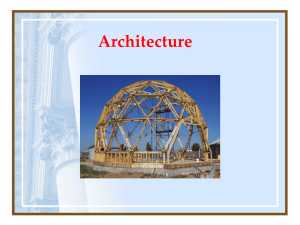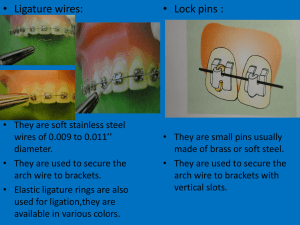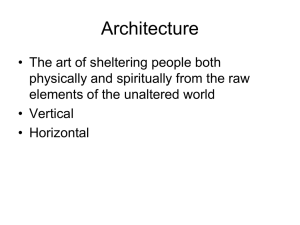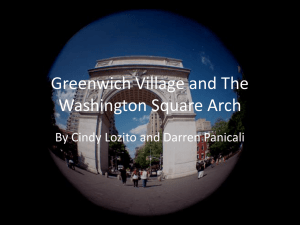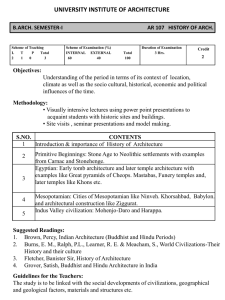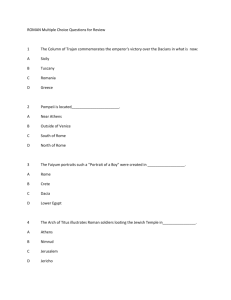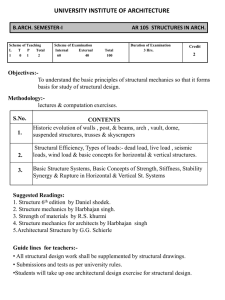ARCH 1115-1116 - School of Architecture + Design
advertisement
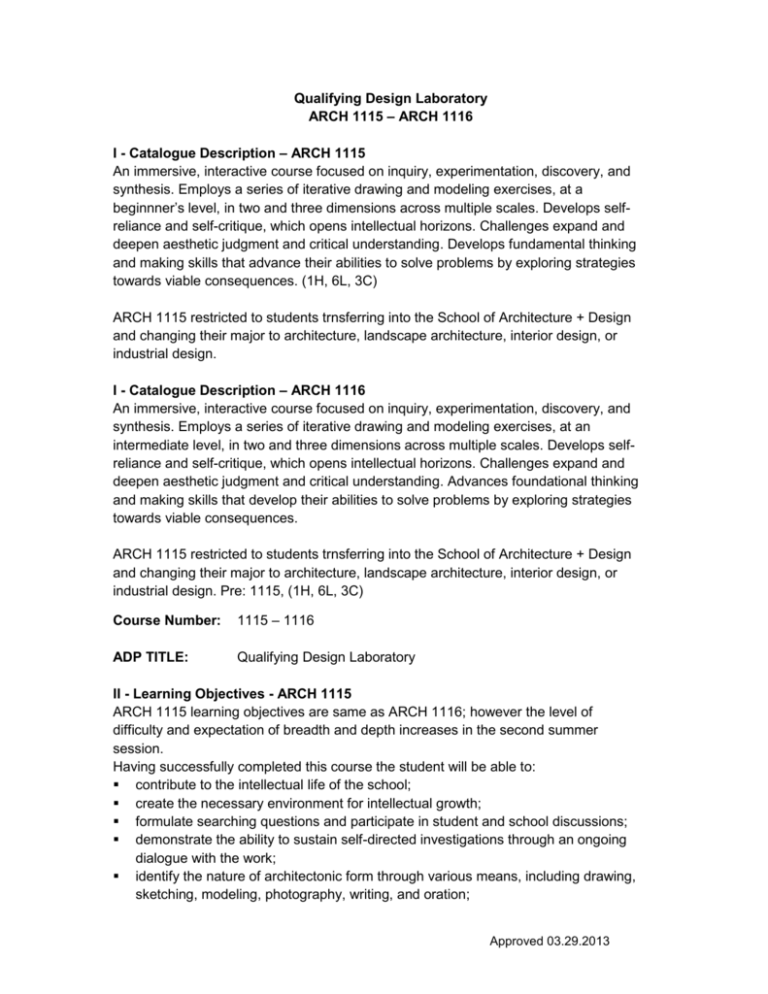
Qualifying Design Laboratory ARCH 1115 – ARCH 1116 I - Catalogue Description – ARCH 1115 An immersive, interactive course focused on inquiry, experimentation, discovery, and synthesis. Employs a series of iterative drawing and modeling exercises, at a beginnner’s level, in two and three dimensions across multiple scales. Develops selfreliance and self-critique, which opens intellectual horizons. Challenges expand and deepen aesthetic judgment and critical understanding. Develops fundamental thinking and making skills that advance their abilities to solve problems by exploring strategies towards viable consequences. (1H, 6L, 3C) ARCH 1115 restricted to students trnsferring into the School of Architecture + Design and changing their major to architecture, landscape architecture, interior design, or industrial design. I - Catalogue Description – ARCH 1116 An immersive, interactive course focused on inquiry, experimentation, discovery, and synthesis. Employs a series of iterative drawing and modeling exercises, at an intermediate level, in two and three dimensions across multiple scales. Develops selfreliance and self-critique, which opens intellectual horizons. Challenges expand and deepen aesthetic judgment and critical understanding. Advances foundational thinking and making skills that develop their abilities to solve problems by exploring strategies towards viable consequences. ARCH 1115 restricted to students trnsferring into the School of Architecture + Design and changing their major to architecture, landscape architecture, interior design, or industrial design. Pre: 1115, (1H, 6L, 3C) Course Number: 1115 – 1116 ADP TITLE: Qualifying Design Laboratory II - Learning Objectives - ARCH 1115 ARCH 1115 learning objectives are same as ARCH 1116; however the level of difficulty and expectation of breadth and depth increases in the second summer session. Having successfully completed this course the student will be able to: contribute to the intellectual life of the school; create the necessary environment for intellectual growth; formulate searching questions and participate in student and school discussions; demonstrate the ability to sustain self-directed investigations through an ongoing dialogue with the work; identify the nature of architectonic form through various means, including drawing, sketching, modeling, photography, writing, and oration; Approved 03.29.2013 demonstrate an attention to detail and precision, using various materials, methods, and tools; identify relationships that the design disciplines share with other arts and sciences; and relate design to cultural values, scientific innovations, and contemporary technological developments. II - Learning Objectives - ARCH 1116 Having successfully completed this course the student will be able to: contribute to the intellectual life of the school; create the necessary environment for intellectual growth; formulate searching questions and participate in student and school discussions; demonstrate the ability to sustain self-directed investigations through an ongoing dialogue with the work; identify the nature of architectonic form through various means, including drawing, sketching, modeling, photography, writing, and oration; demonstrate an attention to detail and precision, using various materials, methods, and tools; identify relationships that the design disciplines share with other arts and sciences; and relate design to cultural values, scientific innovations, and contemporary technological developments. III – Justification This two-summer-session-course-sequence provides a compreshensive overview of basic design concepts, as well as the means to systematically explore those ideas through visual, physical, and verbal modes of communication. ARCH 1115 teaches foundational course content at the basic level and therefore is a prerequesite for ARCH 1116, which has more advanced foundtaional course content. Both are a prerequisite for transferring into the School of Architecture + Design, and changing a student’s major to architecture, landscape architecture, interior design, or industrial design. IV – Prerequisites and Co-requisites ARCH 1115 is a prerequesite for ARCH 1116. ARCH 1115 is introductory level; ARCH 1116 intermediate level. Approved 03.29.2013 V – Texts and Special Teaching Aids Required Texts: No suitable single textbook exists for a course of this type. Readings will be assigned from books, professional journals, essays, published papers, and monographs as deemed necessary by the faculty. Recommended Texts: Albers, Josef, INTERACTION OF COLOR. Revised Edition, New Haven, Yale University Press, 1975. Eames, Charles and Ray, and Morrison, Philip and Phyllis, POWERS OF TEN: About Relative Size of Things in the Universe. Revised Edition, New York, Scientific American Books, 1982. Klee, Paul, PEDAGOGICAL SKETCHBOOK. London, Faber & Faber, 1968. Massimo Vignelli, THE VIGNELLI CANON. Baden, Switzerland, Lars Muller Publishers and the author, 2010. Resources: Images, films, videos, DVD’s, and drawings from the Art & Architecture Library, and from individual faculty collections; Support facilities within the School including pottery, screen-printing, and printmaking studios, FAB LAB, loom-weaving, and photo print rooms; Digital output room equipped with scanners, printers, and plotters for the production of graphics; Equipment for short-term loan to facilitate documentation of work and presentations, including digital cameras, monitors, and projectors; Wood and metal shops, including rapid prototyping technology supervised by technicians; and Exhibition space in Cowgill Hall lobby. VI – Syllabus - ARCH 1115 ARCH 1115 syllabus is same as 1116; however the metric for evaluation of student performance increases for ARCH 1116. 1. FUNDAMENTAL DESIGN CONCEPTS Exercises in relationships of parts to whole and ordering systems, relationships between elements in space, understanding of scale, color, and proportion. (10%) Exercises focused on enhancing visual sensitivity and perceptual skills. (10%) Exercises in drawing, sketching, modeling, photography, writing, and oration. (10%) Percent of Course 40% Approved 03.29.2013 Experiments with materials, traditional tools and emerging technologies with attention to detail and precision. (10%) 2. DESIGN PROCESS Setting limits. Defining the range and scope of investigations. (10%) Assertion of interest. (10%) Self-motivated and self-directed investigations. (10%) Self and peer assessment. (10%) 40% 3. DIALOGUE AND DISCUSSION Participation in design lab and school discussions. (20%) 20% ____ 100% VI – Syllabus - ARCH 1116 1. FUNDAMENTAL DESIGN CONCEPTS Exercises in relationships of parts to whole and ordering systems, relationships between elements in space, understanding of scale, color, and proportion. (10%) Exercises focused on enhancing visual sensitivity and perceptual skills. (10%) Exercises in drawing, sketching, modeling, photography, writing, and oration. (10%) Experiments with materials, traditional tools and emerging technologies with attention to detail and precision. (10%) Percent of Course 40% 2. DESIGN PROCESS Setting limits. Defining the range and scope of investigations. (10%) Assertion of interest. (10%) Self-motivated and self-directed investigations. (10%) Self and peer assessment. (10%) 40% 3. DIALOGUE AND DISCUSSION Participation in design lab and school discussions. (20%) 20% ____ 100% Approved 03.29.2013

